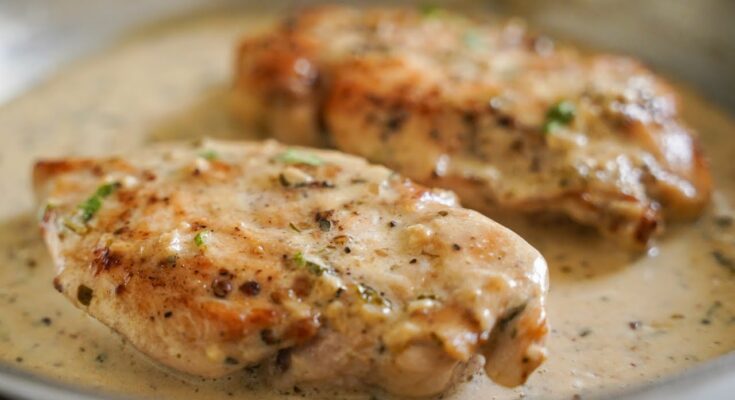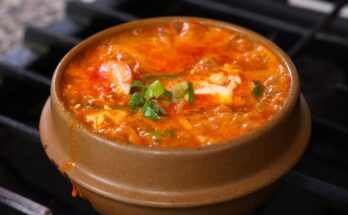Creamed Chicken Recipe: There’s something undeniably cozy about a plate of creamed chicken. It’s warm, rich, and soul-satisfying—kind of like getting a hug from your dinner. Whether you’re looking for a classic comfort meal to beat the chill or a hearty option to use up leftover chicken, this recipe checks every box. Creamed chicken has stood the test of time for a reason: it’s simple, flexible, and, most importantly, downright delicious.
But here’s the thing: while it looks fancy and tastes like it came straight from grandma’s kitchen, making it is way easier than you think. We’re breaking it all down for you—step by step—in this ultimate guide. From the ingredients list to cooking tips and variations, by the time you finish reading, you’ll feel ready to whip up a skillet of creamy goodness like a pro.
What is Creamed Chicken?
Creamed chicken is exactly what it sounds like—succulent pieces of cooked chicken enveloped in a silky, creamy sauce. Think of it as the savory cousin of chicken pot pie without the crust. It typically features shredded or diced chicken, cooked in a butter and flour roux that’s been enriched with milk or cream. Add in a few vegetables and herbs, and voilà—you’ve got yourself a classic American dish that feels like home in every bite.
Its roots are humble. Creamed chicken gained popularity during the Great Depression as a way to stretch meat with inexpensive ingredients like flour and milk. Over time, it became a staple in home kitchens, served over toast, biscuits, rice, or mashed potatoes. And even today, it remains one of those old-school meals that people keep coming back to.
What makes it even better? You can easily customize it with what you have on hand. Got leftover rotisserie chicken? Perfect. Prefer turkey or plant-based protein? Go for it. The creamy base is your playground.
Why You’ll Love This Recipe
Let’s be honest—when it comes to comfort food, creamed chicken is elite. Here’s why you’re going to fall head over heels for this recipe:
- Creamy & Rich: It’s made with a homemade cream sauce that’s luscious without being too heavy.
- Super Versatile: Serve it over toast, pasta, rice, biscuits, or even as a pot pie filling.
- One-Pan Wonder: Fewer dishes, more deliciousness.
- Family Friendly: Picky eaters? No problem. It’s mild, familiar, and customizable.
- Perfect for Leftovers: Got extra chicken from Sunday dinner? This is the best way to give it new life.
If you’re someone who loves dishes that taste like a warm blanket on a cold day, then this recipe’s going to be a favorite.
Ingredients You’ll Need
Before we start stirring, let’s get everything ready. Here’s what you’ll need:
Protein
- 2 to 3 cups of cooked chicken (shredded or diced)
- Rotisserie, roasted, or leftover chicken all work great.
Cream Sauce Base
- 3 tablespoons unsalted butter
- 3 tablespoons all-purpose flour
- 2 cups whole milk (can sub with 1 cup milk + 1 cup cream for extra richness)
- ½ cup heavy cream (optional for added thickness)
- Salt and pepper to taste
Vegetables & Flavor Enhancers
- 1 small onion, finely chopped
- 2 cloves garlic, minced
- ½ cup frozen peas or diced carrots (optional)
- 1 teaspoon dried thyme or poultry seasoning
- ¼ teaspoon paprika (adds color and depth)
Optional Add-ins
- ½ cup grated Parmesan or cheddar cheese
- 1 tablespoon chopped fresh parsley for garnish
- Dash of hot sauce or Dijon mustard for a kick
Having all your ingredients prepped makes the cooking process smoother and way more enjoyable.
Tools and Equipment Required
You don’t need a fancy kitchen to make this magic happen. Here’s what you’ll want on your countertop:
- Large skillet or saucepan (nonstick or cast iron)
- Whisk (for smooth sauce-making)
- Cutting board and knife
- Measuring cups and spoons
- Wooden spoon or spatula
A whisk is especially important—clumpy cream sauce is no one’s idea of tasty.
How to Prepare Chicken for Creamed Chicken
Now, let’s talk chicken. You can use freshly cooked chicken breasts, thighs, or even the remains of a rotisserie chicken. Here’s how to get it ready:
- Boil and Shred: Boil chicken breasts for 12–15 minutes, let them cool slightly, and then shred with two forks.
- Dice Leftovers: Got baked or grilled chicken from last night? Dice it into bite-sized pieces.
- Use Rotisserie Chicken: It’s a massive time-saver and packed with flavor.
Tip: If you’re boiling chicken, throw a bay leaf, onion slice, or celery stick into the water for added flavor.
Whatever method you choose, make sure the chicken is fully cooked, juicy, and easy to break apart. This makes the sauce soak in beautifully.
How to Make the Cream Sauce
Now onto the heart of the dish—the cream sauce. This is where all the flavor magic happens. If you nail the sauce, everything else just falls into place. Don’t worry; it’s not as tricky as it sounds. Once you understand the roux (a butter and flour mixture), the rest is just whisking and seasoning.
Step-by-step for the Cream Sauce:
- Melt the Butter: In a large skillet or saucepan over medium heat, melt 3 tablespoons of butter. Don’t rush this step—melt it slowly so it doesn’t brown or burn.
- Add the Flour: Once the butter is fully melted and slightly bubbling, sprinkle in 3 tablespoons of all-purpose flour. Whisk it constantly to combine with the butter and create a smooth paste. This is your roux and the foundation of the cream sauce.
- Cook the Roux: Cook the butter-flour mixture for about 1–2 minutes, just until it starts to smell a little nutty. This gets rid of the raw flour taste.
- Add the Milk Slowly: Gradually pour in 2 cups of milk (or 1 cup milk and 1 cup cream for a richer version), whisking constantly. The trick here is to add the liquid slowly and stir vigorously to prevent lumps.
- Simmer and Thicken: Turn the heat to medium-low and let the sauce simmer gently. Stir frequently. In about 5–8 minutes, it should thicken to a gravy-like consistency.
- Season It Up: Stir in salt, pepper, a pinch of paprika, and any herbs you’re using (like thyme or poultry seasoning). You can also add garlic powder or onion powder if you’re skipping fresh aromatics.
- Add Heavy Cream (Optional): If you want a richer, silkier sauce, stir in ½ cup of heavy cream at the end. Just warm it through—no boiling needed.
- Cheesy Twist?: Want a cheesy version? Stir in ½ cup of grated Parmesan or sharp cheddar cheese until melted and smooth.
Pro Tip: If the sauce is too thick, add a splash of chicken broth or milk to loosen it up. Too thin? Let it simmer a bit longer or add a bit more roux.
Step-by-Step Guide to Cooking Creamed Chicken
With the chicken prepped and the sauce ready, it’s time to bring it all together. Follow this detailed guide for a foolproof cooking process:
1. Sauté Aromatics
In your skillet, melt a bit of butter or use oil. Add chopped onions and garlic. Cook until soft and translucent (about 3–4 minutes). This builds the base flavor.
2. Mix in Vegetables (Optional)
Want veggies? Add peas, carrots, or even mushrooms now. Cook for 3–5 minutes until they begin to soften. Frozen veggies are totally okay—just thaw them first.
3. Add Cooked Chicken
Stir in your shredded or diced cooked chicken. Mix well with the aromatics and veggies. Let it heat through for a couple of minutes so the flavors begin to blend.
4. Pour in the Cream Sauce
Now, gently pour your prepared cream sauce into the skillet with the chicken mixture. Stir everything together until the chicken is fully coated and bathing in creamy goodness.
5. Simmer
Reduce the heat to low and let the whole mixture simmer for 5–10 minutes. This helps all the flavors meld and allows the sauce to thicken even more. Stir occasionally so nothing sticks to the bottom.
6. Taste and Adjust
Always give it a taste before serving. Need more salt? Pepper? Maybe a pinch of cayenne for heat? Now’s the time to tweak it.
Optional Garnish: Sprinkle with chopped fresh parsley for color and freshness right before serving.
Serving Suggestions
So you’ve got this steaming, creamy, dreamy chicken skillet—now what do you serve it with? The options are endless, and that’s part of the beauty of this dish.
Top Serving Ideas:
- Buttered Toast or Biscuits
This is the traditional, old-school way to serve creamed chicken. Pour it over fluffy biscuits or thick slices of buttered toast. It’s like diner food at its best. - Mashed Potatoes
For maximum comfort, serve it over creamy mashed potatoes. The sauce seeps into the spuds like gravy—absolutely mouthwatering. - Steamed Rice
A great way to stretch this meal for more servings. White or brown rice both work. - Pasta
Pour over egg noodles or fettuccine for a quick twist on chicken alfredo. - Baked Potato
Spoon the creamed chicken into a fluffy baked potato. Bonus points for a sprinkle of cheese and chives. - Vegetables or Zoodles
Looking for a low-carb option? Serve it over sautéed zucchini noodles or steamed broccoli.
Don’t forget a side salad or crusty bread to complete the meal!
Variations to Try
You don’t have to stick to the classic version every time. Here are a few fun and flavorful twists to keep things interesting:
Spicy Creamed Chicken
- Add diced jalapeños or crushed red pepper flakes.
- Stir in a dash of hot sauce or sriracha.
- Use pepper jack cheese for a spicy, creamy kick.
Mushroom Creamed Chicken
- Add 1 cup of sliced mushrooms with the onions.
- Sauté until browned before adding chicken and sauce.
- Use thyme or rosemary for extra depth.
Cheesy Creamed Chicken
- Add shredded cheddar, Swiss, or Parmesan into the sauce.
- A touch of cream cheese makes it extra velvety.
Dairy-Free or Light Version
- Use olive oil instead of butter.
- Sub plant-based milk (unsweetened) and dairy-free creamers.
- Add a splash of lemon juice for brightness.
Herb-Loaded Version
- Mix in chopped fresh herbs like parsley, chives, dill, or basil at the end for a burst of freshness.
How to Store and Reheat Creamed Chicken
Storing
- Let leftovers cool to room temperature.
- Transfer to an airtight container and refrigerate for up to 4 days.
Freezing
- Yes, you can freeze creamed chicken!
- Portion into freezer-safe containers.
- Freeze for up to 2 months.
- Thaw overnight in the fridge before reheating.
Reheating
- Stovetop: Reheat on low in a skillet. Add a splash of milk or broth to loosen the sauce.
- Microwave: Use a microwave-safe dish, cover loosely, and heat in 30-second intervals, stirring in between.
Avoid high heat—you don’t want the cream to separate or curdle.
Tips and Tricks for the Perfect Creamed Chicken
Want to elevate your creamed chicken from good to can’t-stop-eating-it status? Here are some tried-and-true tricks to get that restaurant-quality taste right in your kitchen.
1. Use High-Quality Chicken
Fresh, juicy chicken makes all the difference. If you’re not using rotisserie or leftovers, go with chicken thighs—they have more flavor and stay tender. Dry or overcooked chicken will make your dish taste flat.
2. Season Every Layer
Don’t wait until the end to season. Salt your chicken, taste your roux, and make sure your cream sauce is balanced. Adding herbs and spices gradually helps build deep flavor.
3. Don’t Skip the Roux
A good roux is the backbone of your sauce. Make sure you cook the butter and flour mixture long enough to eliminate any raw flour taste but not so long that it burns.
4. Keep It Smooth
Always whisk your milk into the roux slowly and continuously. This helps you avoid lumps and ensures a velvety sauce. If you do end up with lumps, don’t panic—just strain the sauce through a sieve.
5. Adjust Consistency to Your Liking
Some people like a thicker, spoon-coating sauce, while others prefer a pourable consistency. Adjust by simmering longer (to thicken) or adding a splash of broth or milk (to thin).
6. Add a Flavor Boost
Want to elevate your sauce? Try these add-ins:
- A spoonful of Dijon mustard for tang
- A dash of Worcestershire sauce for umami
- A pinch of nutmeg for warmth
- Lemon zest for brightness
7. Finish with Freshness
Right before serving, stir in chopped herbs or a squeeze of lemon juice. It balances the richness and adds a pop of fresh flavor.
Mastering these small details turns a humble dish into something that tastes like you ordered it from a bistro—but made it in your PJs.
Mistakes to Avoid
Even a simple recipe like creamed chicken can go sideways if you’re not careful. Let’s dodge some common kitchen pitfalls so your dish turns out perfect every single time.
1. Overcooking the Chicken
If your chicken is dry or rubbery, it likely cooked too long. Since you’re adding pre-cooked chicken to the sauce, you only need to warm it through—not cook it again. Simmer gently and avoid boiling.
2. Rushing the Roux
Undercooked roux leads to a raw flour taste that no amount of seasoning can fix. Give it at least 2 minutes of cook time to develop flavor and remove any pasty texture.
3. Adding Milk Too Fast
Dumping all the milk in at once can create lumps. Always add it gradually, whisking constantly to ensure a smooth blend. Slow and steady wins the creamy race.
4. Using Low-Fat or Skim Milk Without Adjustments
Low-fat milk can make your sauce watery and bland. If you’re watching fat content, balance it with a little cornstarch for thickening and add more seasoning to boost flavor.
5. Not Tasting as You Go
This dish relies heavily on seasoning. Salt, pepper, and herbs should be added and adjusted throughout the cooking process. Trust your taste buds—don’t wait until the end!
Avoiding these common missteps will save you from disappointing results and help you turn out a creamy chicken masterpiece every time.
Nutritional Information
Let’s talk numbers. While creamed chicken is a comfort food, you can still make it work with your health goals depending on the ingredients you choose.
| Nutrient | Per Serving (approx.) |
|---|---|
| Calories | 350–500 kcal |
| Protein | 25–30g |
| Fat | 20–30g |
| Carbohydrates | 10–20g |
| Fiber | 1–2g |
| Sugar | 4–6g |
| Sodium | 500–700mg |
Tips for a Healthier Version:
- Use milk instead of cream or choose low-fat milk with a cornstarch slurry for thickening.
- Skip the cheese or use nutritional yeast for a cheesy flavor without the fat.
- Add more veggies like mushrooms, spinach, or bell peppers to bulk up the dish with fewer calories.
- Serve it with cauliflower rice or steamed vegetables instead of mashed potatoes or biscuits.
It’s a flexible recipe that can be adjusted to your dietary needs without sacrificing taste.
FAQs about Creamed Chicken Recipe
1. Can I make creamed chicken ahead of time?
Absolutely! Just prepare the dish as usual, cool it completely, and refrigerate in an airtight container. When you’re ready to eat, reheat gently on the stovetop or in the microwave.
2. Is creamed chicken gluten-free?
Not in its traditional form, since it uses a flour-based roux. But you can make it gluten-free by swapping the flour for a gluten-free all-purpose blend or using cornstarch slurry instead.
3. What’s the best type of chicken to use?
Cooked, shredded chicken breasts or thighs are ideal. Rotisserie chicken is a time-saving option that adds extra flavor. Just avoid under-seasoned or overcooked chicken.
4. Can I freeze creamed chicken?
Yes, it freezes well! Just cool it completely, store in airtight containers, and freeze for up to 2 months. Thaw in the fridge overnight before reheating.
5. How do I fix a sauce that’s too runny or too thick?
If it’s too thin, simmer it longer to reduce. If it’s too thick, whisk in a bit more milk or broth. Always adjust slowly—small tweaks make a big difference.
Conclusion
Creamed chicken isn’t just another comfort food—it’s a delicious way to turn basic ingredients into something extraordinary. Whether you’re using up leftovers or whipping up a fresh batch, this recipe gives you the tools to make something warm, hearty, and satisfying every time.
We walked through every step—from building a smooth, rich cream sauce to choosing your perfect side dish. With a few tricks and a little creativity, you can make this dish truly your own. So go ahead—grab that skillet, pour yourself a cozy bowl of creamed chicken, and enjoy the kind of meal that makes everyone ask for seconds.
Because honestly, isn’t that the best kind of cooking?



